
Vincent Willem van Gogh was a Dutch Post-Impressionist painter who is among the most famous and influential figures in the history of Western art. In just over a decade he created approximately 2100 artworks, including around 860 oil paintings, most of them in the last two years of his life. They include landscapes, still lifes, portraits and self-portraits, and are characterised by bold, symbolic colours, and dramatic, impulsive and highly expressive brushwork that contributed to the foundations of modern art. Only one of his paintings was known by name to have been sold during his lifetime. Van Gogh became famous after his suicide at age 37, which followed years of poverty and mental illness.

The Potato Eaters is an oil painting by Dutch artist Vincent van Gogh painted in April 1885 in Nuenen, Netherlands.
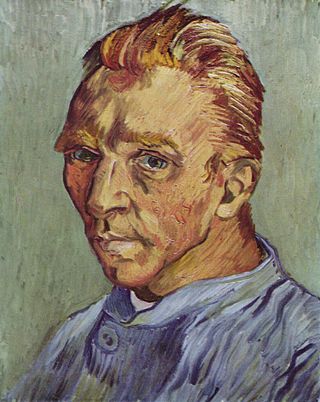
The portraits of Vincent van Gogh (1853–1890) include self-portraits, portraits of him by other artists, and photographs—one of which is dubious—of the Dutch artist. Van Gogh's dozens of self-portraits were an important part of his œuvre as a painter. Most probably, van Gogh's self-portraits are depicting the face as it appeared in the mirror he used to reproduce his face, i.e. his right side in the image is in reality the left side of his face.

Theodorus van Gogh was a Dutch art dealer, the younger brother of Vincent van Gogh. Theo's unfailing financial and emotional support allowed his brother to devote himself entirely to painting. Theo died at the age of 33, six months after his brother died at the age of 37. At his death Theo owned practically all of his brother's artwork. Theo's widow Johanna van Gogh-Bonger worked tirelessly to promote the work of Vincent and keep the memory of her husband alive. Theo made a significant impact on the art world as an art dealer, playing a crucial role in the introduction of contemporary French art to the public. His widow was able to draw on the connections that Theo made to promote Vincent's work. In 1914, she reburied Theo's remains next to Vincent's.
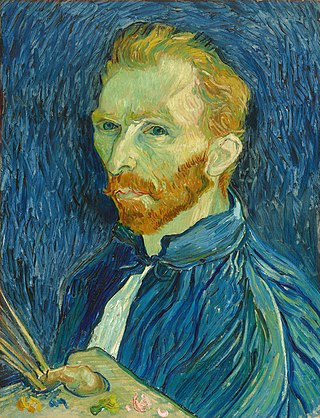
This is a chronology of the artist Vincent van Gogh. It is based as far as possible on Van Gogh's correspondence. However, it has only been possible to construct the chronology by drawing on additional sources. Most of his letters are not dated and it was only in 1973 that a sufficient dating was established by Jan Hulsker, subsequently revised by Ronald Pickvance and marginally corrected by others. Many other relevant dates in the chronology derive from the biographies of his brother Theo, his uncle and godfather Cent, his friends Émile Bernard and Paul Gauguin, and others.

Johanna Gezina van Gogh-Bonger was a multilingual Dutch editor and translator of the letters of the van Gogh brothers. As the wife of art dealer Theo van Gogh, she was the sister-in-law of the painter Vincent van Gogh.

Emmy Eugenie Andriesse was a Dutch photographer best known for her work with the Underground Camera group during World War II.
Saskia Olde Wolbers is a Dutch video artist who lives and works in London.
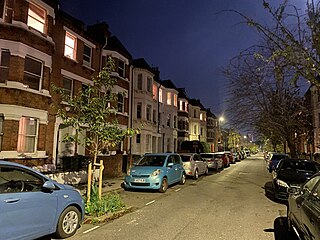
Hackford Road is a road in Oval, Lambeth, south London, England. It runs north–south and is located between Clapham Road (A3) to the west and Brixton Road (A23) to the east. To the north is the Oval tube station.

The Montmartre paintings are a group of works that Vincent van Gogh created in 1886 and 1887 of the Paris district of Montmartre while living there, at 54 Rue Lepic, with his brother Theo. Rather than capture urban settings in Paris, van Gogh preferred pastoral scenes, such as Montmartre and Asnières in the northwest suburbs. Of the two years in Paris, the work from 1886 often has the dark, somber tones of his early works from the Netherlands and Brussels. By the spring of 1887, van Gogh embraced use of color and light and created his own brushstroke techniques based upon Impressionism and Pointillism. The works in the series provide examples of his work during that period of time and the progression he made as an artist.

The earliest known works of Vincent van Gogh comprise a group of paintings and drawings that Vincent van Gogh made when he was 27 and 28, in 1881 and 1882. Over the course of the two-year period Van Gogh lived in several places. He left Brussels, where he had studied for about a year in 1881, to return to his parents’ home in Etten, where he made studies of some of the residents of the town. In January 1882 Van Gogh went to The Hague where he studied with his cousin-in-law Anton Mauve and set up a studio, funded by Mauve. During the ten years of Van Gogh's artistic career from 1881 to 1890 Vincent's brother Theo would be a continuing source of inspiration and financial support; his first financial support began in 1880 funding Vincent while he lived in Brussels.

Van Gogh's family in his art refers to works that Vincent van Gogh made for or about Van Gogh family members. In 1881, Vincent drew a portrait of his grandfather, also named Vincent van Gogh, and his sister Wil. While living in Nuenen, Vincent memorialized his father in Still Life with Bible following his death in 1885. There he also made many paintings and drawings in 1884 and 1885 of his parents' vicarage, its garden and the church. At the height of his career in Arles he made Portrait of the Artist's Mother, Memory of the Garden at Etten of his mother and sister and Novel Reader, which is thought to be of his sister, Wil.
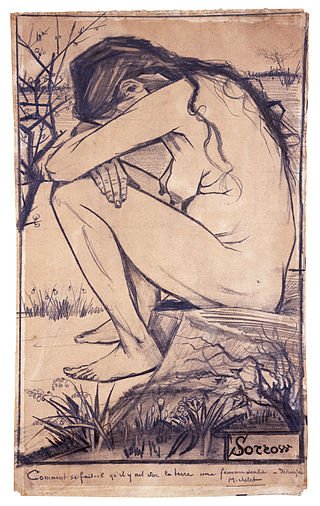
Vincent van Gogh drew and painted a series of works of his mistress Sien during their time together in the Netherlands. In particular, his drawing Sorrow is widely acknowledged as a masterwork of draftsmanship, the culmination of a long and sometimes uncertain apprenticeship in learning his craft.

Southampton Street is a street in central London, running north from the Strand to Covent Garden Market.
The events that befell the early paintings and drawings by Vincent van Gogh in the period prior to the posthumous recognition of Vincent van Gogh as an innovative artist show how the appreciation of his legacy changed his reputation in a relatively short time.

Skull of a Skeleton with Burning Cigarette is an early work by Vincent van Gogh. The small and undated oil-on-canvas painting featuring a skeleton and cigarette is part of the permanent collection of the Van Gogh Museum in Amsterdam. It was most likely painted in the winter of 1885–86 as a satirical comment on conservative academic practices. Before it was common to use live humans as models, the academic routine included the study of skeletons to develop an understanding of human anatomy. Van Gogh was in Antwerp, Belgium at that time attending classes at the Royal Academy of Fine Arts, which he later said were boring and taught him nothing.
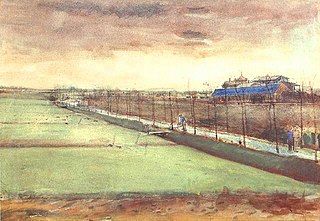
Meadows near Rijswijk and the Schenkweg is a watercolor by the Dutch painter Vincent van Gogh that he made in January 1882, shortly after taking up residence in The Hague.

Sorrow is a drawing by Vincent van Gogh, produced in 1882.

Memory of the Garden at Etten (Ladies of Arles) is an oil painting by Vincent van Gogh. It was executed in Arles around November 1888 and is in the collection of the Hermitage Museum. It was intended as decoration for his bedroom at the Yellow House.

Liesbeth Heenk is an international publisher, author and art historian specialised in Vincent van Gogh. She is the founder of Amsterdam Publishers which is the largest international publisher of Holocaust memoirs in Europe.

















